简介
Spring的理念:
保持强大的向后兼容性
高质量的源码格式
解决企业应用的复杂性, 使现有的技术更加容易使用
1 | <!-- https://mvnrepository.com/artifact/org.springframework/spring-webmvc --> |
1 | <!-- https://mvnrepository.com/artifact/org.springframework/spring-jdbc --> |
优点
- Spring是一个免费的开源的框架(容器)
- Spring是一个轻量级的, 非入侵式的框架
- 控制反转(IOC) , 面向切面编程(AOP)
- 支持事物的处理, 对框架整合的支持
Spring的组成及拓展
组成

拓展
在Spring的官网, 有这样的介绍
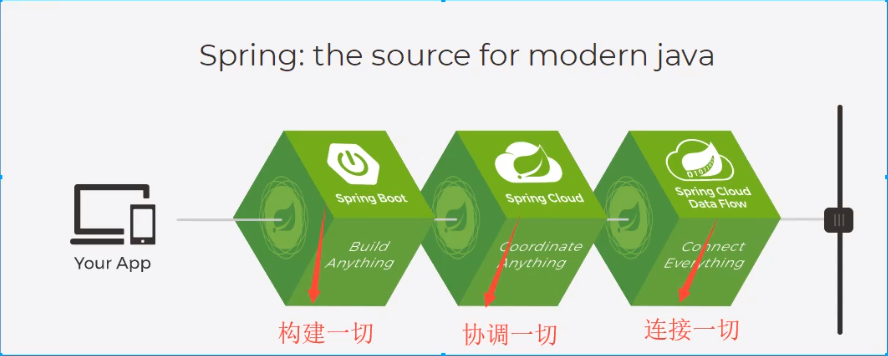
Spring Boot
一个快速开发的脚手架, 基于它可以快速开发单个微服务
约定大于配置
学习SpringBoot的前提, 需要完全掌握Spring及SpringMVC
Spring Cloud
基于Spring Boot实现的, 微服务的协调与整合
IOC理论推导
在之前的业务中, 用户的需求会影响我们原来的代码, 我们需要根据用户的需求去修改原代码!
如果程序代码量十分大, 修改一次的成本很高
使用一个set接口实现:
1 | private UserDao userDao; |
已经发生了革命性的变化
- 之前, 程序是主动创建对象, 控制权在程序员手上 !
- 使用了set注入后, 程序不再具有主动性, 而是变成了被动的接受对象 !
这种思想从本质上解决了问题, 程序员不用再去管理对象的创建了, 系统的耦合性大大降低, 可以更加专注地业务的扩展上, 这就是IOC的原型
IOC本质
控制反转(Inversion of Control), 是一种设计思想, DI(依赖注入)是实现IOC的一种方法, 也有人认为DI只是IOC的另一种说法. 没有IOC的程序中, 我们使用面向对象编程, 对象的创建间的依赖关系完全硬编码在程序中, 对象的创建由程序自己控制, 控制反转后将对象的创建转移给第三方, 个人认为所谓控制反转就是: 获得依赖对象的方式反转了.
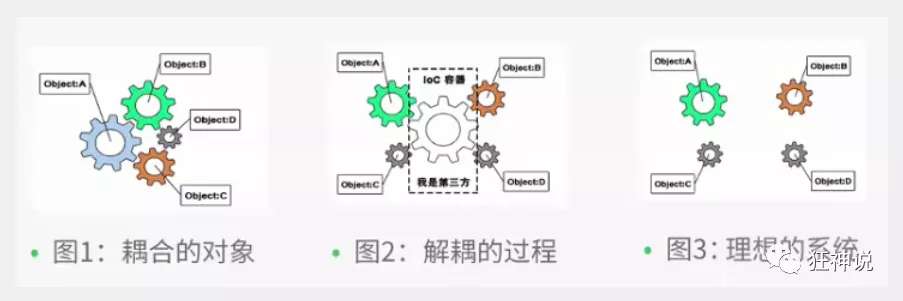
IoC是Spring框架的核心内容,使用多种方式完美的实现了IoC,可以使用XML配置,也可以使用注解,新版本的Spring也可以零配置实现IoC。
Spring容器在初始化时先读取配置文件,根据配置文件或元数据创建与组织对象存入容器中,程序使用时再从Ioc容器中取出需要的对象。

控制反转是一种通过描述(XML或注解)并通过第三方去生产或获取特定对象的方式。在Spring中实现控制反转的是IoC容器,其实现方法是依赖注入(Dependency Injection,DI)。
HelloSpring
新建工程, 导入Spring的包
新建实体类:
1
2
3
4
5
6
7
8
9
10
11
12
13
14
15
16
17
18
19
20
21
22
23
24
25
26public class Hello {
private String str;
public Hello() {
}
public Hello(String str) {
this.str = str;
}
public String getStr() {
return str;
}
public void setStr(String str) {
this.str = str;
}
public String toString() {
return "Hello{" +
"str='" + str + '\'' +
'}';
}
}新建Spring配置文件
beans.xml1
2
3
4
5
6
7
8
9
10
11
<beans xmlns="http://www.springframework.org/schema/beans"
xmlns:xsi="http://www.w3.org/2001/XMLSchema-instance"
xsi:schemaLocation="http://www.springframework.org/schema/beans
https://www.springframework.org/schema/beans/spring-beans.xsd">
<bean id="hello" class="com.lxb.pojo.Hello">
<property name="str" value="Spring"/>
</bean>
</beans>注意不能有中文注释, 不然会报错
编写测试代码
1
2
3
4
5
6
7
8
9
10
11public class MyTest {
public static void main(String[] args) {
// 获取Spring的上下文对象
ApplicationContext context = new ClassPathXmlApplicationContext("beans.xml");
// 我们的对象现在都在Spring中管理
Hello hello = (Hello) context.getBean("hello");
System.out.println(hello.toString());
}
}结果为:
1
Hello{str='Spring'}
分析:
使用Spring 来创建对象, 在Spring里这些成为Bean
在之前创建对象的方式为:
1 | 类型 变量名 = new 类型(); |
在配置文件中
id: 对应变量名
class: 对应类型
property: 给对象中的属性设置一个值 (通过set 方法进行注入)
创建如下的项目结构:
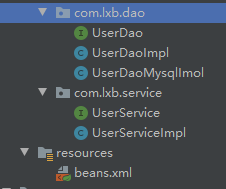
UserServiceImpl实例中可以存放两个对象, xml文件为:
1 |
|
分别创建了两个beanuserDaoImpl 和 userDaoMysqlImpl, 然后userServiceImpl 中的一个属性可以自由修改为上述两个bean 中的任意一个, 只需要将bean的id写入ref字段后即可
ref: 引用已经在Spring中注册过的bean
*value: * 赋一个定值
1 |
|
OK, 到了现在, 我们彻底不用在程序中改动了, 要实现不同的操作, 只需要在XML配置文件中进行修改, 所谓的IOC,一句话搞定: 对象由Spring来创建, 管理, 装配!!
IOC创建对象的方式
使用无参构造器创建, 默认!
1
2
3<bean id="user" class="com.lxb.pojo.User">
<property name="name" value="lxb"/>
</bean>这里的property是赋值操作, 创建对象调用的还是无参构造器 !

使用有参构造器创建
方式一: 下标赋值
1
2
3<bean id="user" class="com.lxb.pojo.User">
<constructor-arg index="0" value="lxb"/>
</bean>方式二: 类型匹配
1
2
3<bean id="user" class="com.lxb.pojo.User">
<constructor-arg type="java.lang.String" value="lxb"/>
</bean>不建议使用
方式三: 属性名匹配
1
2
3<bean id="user" class="com.lxb.pojo.User">
<constructor-arg name="name" value="lxb"/>
</bean>
注意:
所有Bean在注册好之后就已经创建好实例对象且只有一份, 就像婚介所, 只要一注册, 那么就能够时刻被其他人调用查看, 想要哪个对象, 往婚介所里取就行. 婚介所里每个类只有一个实例, 无论取多少次都不会增加.
Spring配置
别名
给已经配置完成的Bean对象起个别名
1 | <alias name="user" alias="u1"/> |
1 | public static void main(String[] args) { |
输出为:

Bean的配置
*id: * bean的唯一标识符, 也就是相当于我们学的对象名
*class: * bean对象所对应的权限定名: 包名+类型
*name: * 也是别名, 而且可以取多个别名, 用逗号或者空格或者分号隔开即可
import
这个import, 一般用于团队开发使用, 它可以将多个配置文件, 导入合并为一个
假设项目中有多个人开发, 每个人负责不同的类开发, 不同的类注册在不同的BEAN中, 我们可以利用import将所有人的BRANS.XML合并为一个总的, 使用的时候直接使用总的即可
DI依赖注入
构造器注入
前面已经说过了
Set方式注入[重点]
- 依赖注入: 本质就是Set注入!
- 依赖: bean对象的创建依赖于容器
- 注入: bean对象中的所有属性, 由容器来注入
环境搭建
创建一个较为复杂的实体类:
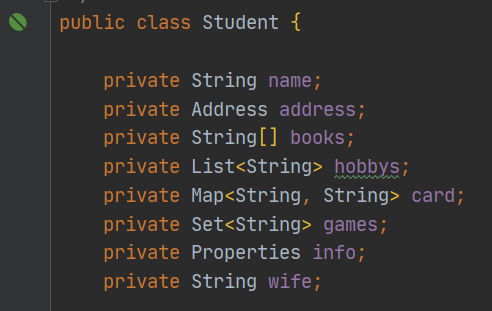
Student.java
1
2
3
4
5
6
7
8
9
10
11
12
13
14
15
16
17
18
19
20
21
22
23
24
25
26
27
28
29
30
31
32
33
34
35
36
37
38
39
40
41
42
43
44
45
46
47
48
49
50
51
52
53
54
55
56
57
58
59
60
61
62
63
64
65
66
67
68
69
70
71
72
73
74
75
76
77
78
79
80
81
82
83
84
85
86
87
88
89
90
91
92
93
94
95
96
97package com.lxb.pojo;
import java.util.*;
/**
* @author Lxb0124
* @create 2020-07-25 16:05
*/
public class Student {
private String name;
private Address address;
private String[] books;
private List<String> hobbys;
private Map<String, String> card;
private Set<String> games;
private Properties info;
private String wife;
public String getName() {
return name;
}
public void setName(String name) {
this.name = name;
}
public Address getAddress() {
return address;
}
public void setAddress(Address address) {
this.address = address;
}
public String[] getBooks() {
return books;
}
public void setBooks(String[] books) {
this.books = books;
}
public List<String> getHobbys() {
return hobbys;
}
public void setHobbys(List<String> hobbys) {
this.hobbys = hobbys;
}
public Map<String, String> getCard() {
return card;
}
public void setCard(Map<String, String> card) {
this.card = card;
}
public Set<String> getGames() {
return games;
}
public void setGames(Set<String> games) {
this.games = games;
}
public Properties getInfo() {
return info;
}
public void setInfo(Properties info) {
this.info = info;
}
public String getWife() {
return wife;
}
public void setWife(String wife) {
this.wife = wife;
}
public String toString() {
return "Student{" +
"name='" + name + '\'' +
", address=" + address +
", books=" + Arrays.toString(books) +
", hobbys=" + hobbys +
", card=" + card +
", games=" + games +
", info=" + info +
", wife='" + wife + '\'' +
'}';
}
}Address.java
1
2
3
4
5
6
7
8
9
10
11
12
13
14
15
16
17public class Address {
private String address;
public Address() {
}
public Address(String address) {
this.address = address;
}
public String toString() {
return "Address{" +
"address='" + address + '\'' +
'}';
}
}beans.xml
1
2
3
4
5
6
7
8
9
10
11
12
13
14
15
16
17
18
19
20
21
22
23
24
25
26
27
28
29
30
31
32
33
34
35
36
37
38
39
40
41
42
43
44
45
46
47
48
49
50
51
52
53
54
55
56
57
58
59
60
61
62
63
<beans xmlns="http://www.springframework.org/schema/beans"
xmlns:xsi="http://www.w3.org/2001/XMLSchema-instance"
xsi:schemaLocation="http://www.springframework.org/schema/beans http://www.springframework.org/schema/beans/spring-beans.xsd">
<bean id="address" class="com.lxb.pojo.Address">
<constructor-arg name="address" value="Route66"/>
</bean>
<bean id="student" class="com.lxb.pojo.Student">
<property name="name" value="lxb"/>
<property name="address" ref="address"/>
<property name="books">
<array>
<value>book1</value>
<value>book2</value>
<value>book3</value>
<value>book4</value>
</array>
</property>
<property name="hobbys">
<list>
<value>music</value>
<value>coding</value>
<value>movies</value>
</list>
</property>
<property name="card">
<map>
<entry key="IDCard" value="41011613613132"/>
<entry key="bankCard" value="894654621321"/>
</map>
</property>
<property name="games">
<set>
<value>CF</value>
<value>DNF</value>
<value>DOTA2</value>
<value>LOL</value>
</set>
</property>
<property name="wife">
<null/>
</property>
<property name="info">
<props>
<prop key="id">MF19230500653</prop>
<prop key="sex">Male</prop>
<prop key="username">zzz660004133</prop>
<prop key="password">123465</prop>
</props>
</property>
</bean>
</beans>MyTest.java
1
2
3
4
5
6
7
8public class MyTest {
public void test(){
ApplicationContext context = new ClassPathXmlApplicationContext("beans.xml");
Student student = (Student) context.getBean("student");
System.out.println(student.toString());
}
}输出结果为:
1
2
3
4
5
6
7
8
9
10
11
12
13
14
15
16
17
18Student{
name='lxb',
address=Address{address='Route66'},
books=[book1, book2, book3, book4],
hobbys=[music, coding, movies],
card={
IDCard=41011613613132,
bankCard=894654621321
},
games=[CF, DNF, DOTA2, LOL],
info={
password=123465,
sex=Male,
id=MF19230500653,
username=zzz660004133
},
wife='null'
}
拓展方式
P命名空间注入
就是property 的简化, 可以直接注入属性的值, 对应的是set 方式的注入
在xml文件上方添加
1 | xmlns:p="http://www.springframework.org/schema/p" |
在bean语句中使用:
1 | <bean id="user" class="com.lxb.pojo.User" p:name="lxb" p:age="18"/> |
C命名空间注入
对应的是构造器注入, 必须要有有参构造器
在xml文件上方添加
1 | xmlns:c="http://www.springframework.org/schema/c" |
在bean语句中使用:
1 | <bean id="user" class="com.lxb.pojo.User" c:name="lxb" c:age="23"/> |
Bean的作用域
| Scope | Description |
|---|---|
| singleton | (Default) Scopes a single bean definition to a single object instance for each Spring IoC container. |
| prototype | Scopes a single bean definition to any number of object instances. |
| request | Scopes a single bean definition to the lifecycle of a single HTTP request. That is, each HTTP request has its own instance of a bean created off the back of a single bean definition. Only valid in the context of a web-aware Spring ApplicationContext. |
| session | Scopes a single bean definition to the lifecycle of an HTTP Session. Only valid in the context of a web-aware Spring ApplicationContext. |
| application | Scopes a single bean definition to the lifecycle of a ServletContext. Only valid in the context of a web-aware Spring ApplicationContext. |
| websocket | Scopes a single bean definition to the lifecycle of a WebSocket. Only valid in the context of a web-aware Spring ApplicationContext. |
Singleton 单例模式(默认机制)

1 |
|

虽然调用了两次, 但是只生成了一个实例, 这就是单例, 全局共享一个
可以在配置bean时, 显式地标注清楚
1 | <bean id="user" class="com.lxb.pojo.User" c:name="lxb" c:age="23" scope="singleton"/> |
prototype 原型模式
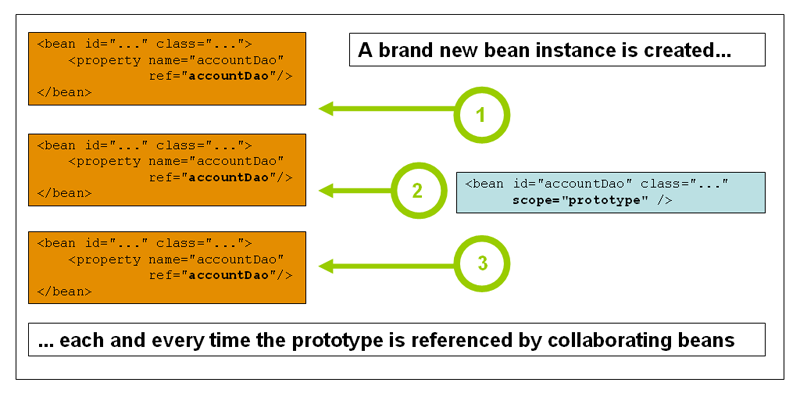
1 | <bean id="user" class="com.lxb.pojo.User" c:name="lxb" c:age="23" scope="prototype"/> |
1 |
|
输出为 false
每次从容器中get的时候, 都会产生一个新对象
Bean的自动装配
- 自动装配Spring满足bean依赖的一种方式
- Spring会在上下文中自动寻找, 并自动给bean装配属性
在Spring中有三种装配的方式:
- 在xml中显示的配置
- 在java中显示配置
- 隐式的自动装配bean 重要
测试
搭建环境, 一个人有两个宠物
public class Cat { public void shout(){ System.out.println("miao~"); } } <!--29-->public class Human { private Cat cat; private Dog dog; private String name; public Human() { } public Human(Cat cat, Dog dog, String name) { this.cat = cat; this.dog = dog; this.name = name; } public Cat getCat() { return cat; } public void setCat(Cat cat) { this.cat = cat; } public Dog getDog() { return dog; } public void setDog(Dog dog) { this.dog = dog; } public String getName() { return name; } public void setName(String name) { this.name = name; } public String toString() { return "Human{" + "cat=" + cat + ", dog=" + dog + ", name='" + name + '\'' + '}'; } } <!--30-->public void test(){ ApplicationContext context = new ClassPathXmlApplicationContext("beans.xml"); Human human = context.getBean("human", Human.class); human.getCat().shout(); human.getDog().shout(); System.out.println(human.toString()); } <!--31--> miao~ wang!! Human{cat=com.lxb.pojo.Cat@397fbdb, dog=com.lxb.pojo.Dog@33d512c1, name='lxb'} <!--32-->
测试结果为:
1 | miao~ |
说明自动装配成功
会自动在容器上下文中查找, 和自己对象set方法后面的值对应的bean id
ByType自动装配
使用bytpe自动装配的话, 就不需要bean id与属性名相同了, 只要类型相同即可
会自动在容器上下文中查找, 和自己对象属性类型相同的bean
使用注解实现自动装配
The introduction of annotation-based configuration raised the question of whether this approach is “better” than XML. The short answer is “it depends.”
使用须知:
导入约束
1
xmlns:context="http://www.springframework.org/schema/context"
配置注解的支持
1
2
3
4
5
6
7
8
9
10
11
12
<beans xmlns="http://www.springframework.org/schema/beans"
xmlns:xsi="http://www.w3.org/2001/XMLSchema-instance"
xmlns:context="http://www.springframework.org/schema/context"
xsi:schemaLocation="http://www.springframework.org/schema/beans
https://www.springframework.org/schema/beans/spring-beans.xsd
http://www.springframework.org/schema/context
https://www.springframework.org/schema/context/spring-context.xsd">
<context:annotation-config/>
</beans>根据官方文档修改我们的项目为:
1
2
3
4
5
6
7
8
9
10
11
12
13
14
15
16
<beans xmlns="http://www.springframework.org/schema/beans"
xmlns:xsi="http://www.w3.org/2001/XMLSchema-instance"
xmlns:context="http://www.springframework.org/schema/context"
xsi:schemaLocation="http://www.springframework.org/schema/beans
http://www.springframework.org/schema/beans/spring-beans.xsd
http://www.springframework.org/schema/context
http://www.springframework.org/schema/context/spring-context.xsd">
<context:annotation-config/>
<bean id="cat" class="com.lxb.pojo.Cat"/>
<bean id="dog" class="com.lxb.pojo.Dog"/>
<bean id="human" class="com.lxb.pojo.Human"/>
</beans>直接在属性上使用@Autowired注解即可, 也可以在set方式上使用!
使用注解的话就不用编写set方法
前提是这个自动装配的属性在 IOC容器中, 且满足byType的要求, 如果唯一则注入, 否则按byName查找
小知识:
1 | @Nullable 字段标记了这个注解, 说明这个字段可以为NULL |
Autowired注解的源代码为:
1 | ({ElementType.CONSTRUCTOR, ElementType.METHOD, ElementType.PARAMETER, ElementType.FIELD, ElementType.ANNOTATION_TYPE}) |
如果显式地定义了required属性为false, 说明这个对象可以为null, 否则不允许为空
1 | (required = false) |
如果@Autowired自动装配的环境比较复杂, 自动装配无法通过一个注解完成的时候, 我们可以使用@Qualifier(value=”xxx”)去配置@Autowired的使用, 指定一个唯一的bean对象注入.
小结
- byname的时候, 需要保证所有bean的id唯一, 并且这个bean需要和自动注入的属性的set方法中传入参数值一致
- bytype的时候, 需要保证所有bean的class唯一, 并且这个bean需要和自动注入的属性的类型一致
使用注解开发
在Spring4之后, 要使用注解开发, 必须保证aop的包已经导入
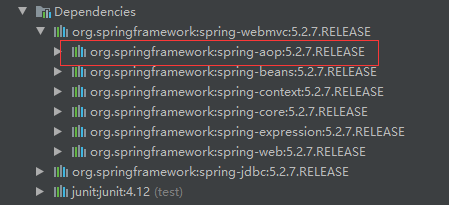
使用注解需要导入注解约束
1 |
|
对象创建
在xml文件中添加这行代码:
1 | <context:component-scan base-package="com.lxb.dao"/> |
表示往这个包下扫描组件
然后创建新的实体类
1 |
|
这里使用了@Component注解, 它的作用就等价于<bean id="user" class="com.lxb.pojo.User"/>
然后测试, 还是要依托于xml文件.
1 |
|
能够正常输出
属性注入
1 |
|
这里的@value注解就相当于
衍生的注解
@Component有几个衍生注解, 我们在web开发中, 会按照mvc三层架构分层!
- dao: @Repository
- service: @Service
- controller: @Controller
这四个功能都是一样的, 都是代表将某个类注册到Spring中, 装配bean
自动装配
- @Autowired: 自动装配通过类型, 名字
- @Nullable: 字段标明了这个注解, 说明这个字段可以为null
- @Qualifier(value=”xxx”): 如果@Autowired不能唯一自动装配上属性, 则需要通过该注解指定
作用域
@Scope: singleton, prototype
小结
xml与注解
- xml更加万能, 适用于任何场合, 维护简单方便
- 注解无法引用其他的bean, 维护相对复杂
最佳实践:
xml用来管理bean
注解只负责完成属性的注入
我们在使用过程中, 只需要注意一个问题: 必须让注解生效, 就需要开启注解的支持
简单了解: 完全抛弃xml的开发方式
需要一个java类来代替之前的XML
1
2
3
4
5
6
7
8
9
10
11
12
13
14/**
* @author Lxb0124
* @create 2020-07-26 13:13
*/
("com.lxb.pojo")
public class MyConfig {
public User user(){
return new User();
}
}这里的@Configuation注解表示这是一个装配类,@Bean注解代替了
标签 在测试调用的时候也要修改代码:
1
2
3
4
5
6
7public class MyTest {
public static void main(String[] args) {
ApplicationContext context = new AnnotationConfigApplicationContext(MyConfig.class);
User getUser = (User) context.getBean("user");
System.out.println(getUser.getName());
}
}
代理模式
为什么要学习代理模式?因为这就是SpringAOP的底层 SpringAOP和SpringMVC
代理模式的分类:
- 静态代理
- 动态代理
静态代理
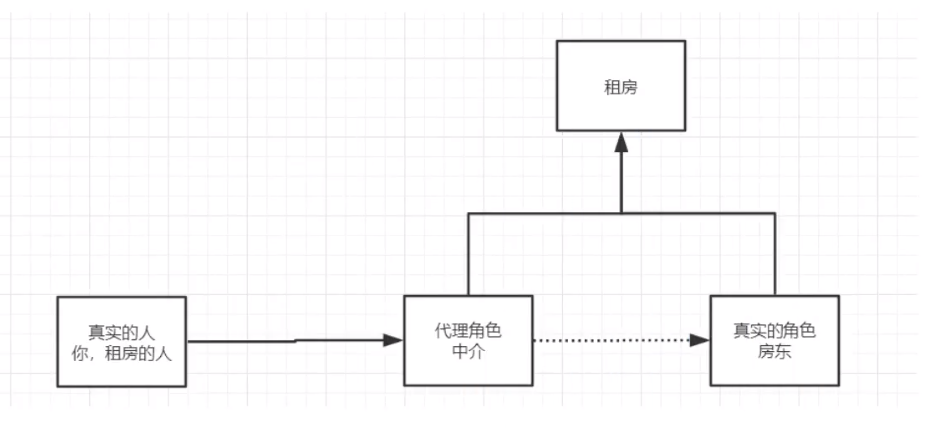
角色分析
- 抽象角色: 一般会使用接口或者抽象类去解决
- 真实角色: 被代理的角色
- 代理角色: 代理真实角色, 代理真实角色后, 我们一般会做一些附属操作
- 客户: 访问代理对象的人
租房的例子
首先, 我们创建一个接口, 表示租房这个行为:
1 | public interface Rent { |
然后创建一个房东类, 他重写了接口中的方法, 表示他要出租房子 真实角色
1 | public class Host implements Rent{ |
然后创建一个中介类, 他在实现了出租房子的基础上, 实现了很多附属操作 代理角色
1 | public class Proxy implements Rent{ |
创建一个客户类, 模拟租房行为
1 | public class Client { |
代理模式的好处:
- 可以使真实角色的操作更加纯粹, 不用去关注一些公共的业务
- 公共的业务就交给代理角色, 实现了业务的分工
- 公共业务发生扩展的时候, 方便集中管理
- 一个动态代理类代理的是一个接口, 一般就是对应的一类业务
- 一个动态代理类可以代理多个类, 只要是实现了同一个接口即可
缺点
- 一个真实角色就会产生一个代理角色, 代码量会翻倍, 开发效率低
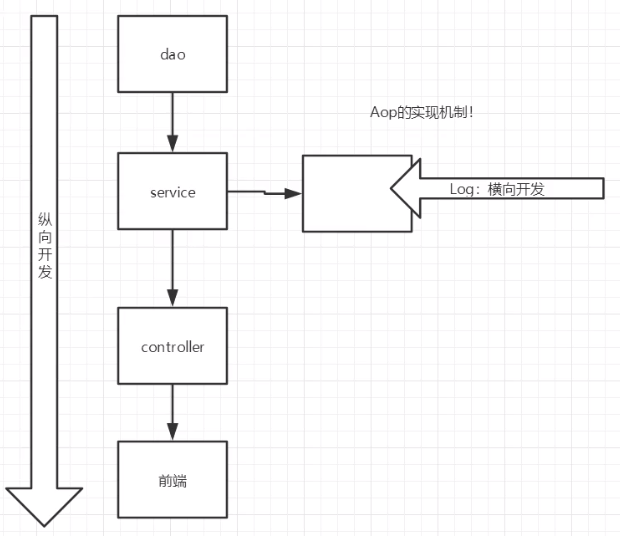
动态代理
- 动态代理和静态代理的角色一样
- 动态代理的代理类是动态生成的, 不是我们直接写好的
- 动态代理分为两大类:
- 基于接口的动态代理
- JDK动态代理
- 基于类的动态代理
- cglib
- 基于接口的动态代理
需要了解两个类: Proxy, InvocationHandler
InvocationHandler
InvocationHandler是由代理实例的调用处理程序实现的接口 。
每个代理实例都有一个关联的调用处理程序。 当在代理实例上调用方法时,方法调用将被编码并分派到其调用处理程序的invoke方法。
1 | public class ProxyInvocationHandler implements InvocationHandler { |
然后创建一个Client 类
1 | public class Client { |
AOP
简介
AOP(Aspect Oriented Programming)意为: 面向切面编程, 通过预编译方式和运行期动态代理实现程序功能的统一维护的一种技术. AOP是OOP的延续, 是函数式编程的一种衍生范式. 利用AOP可以对业务逻辑的各个部分进行隔离, 从而使得业务逻辑各部分之间的耦合度降低, 提高程序的可重用性, 同时提高了开发的效率.
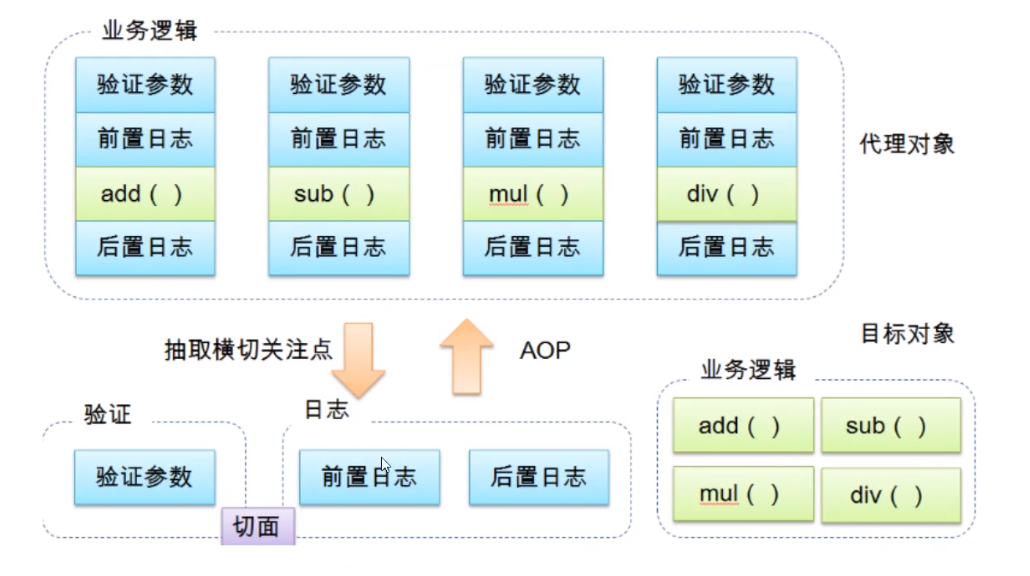
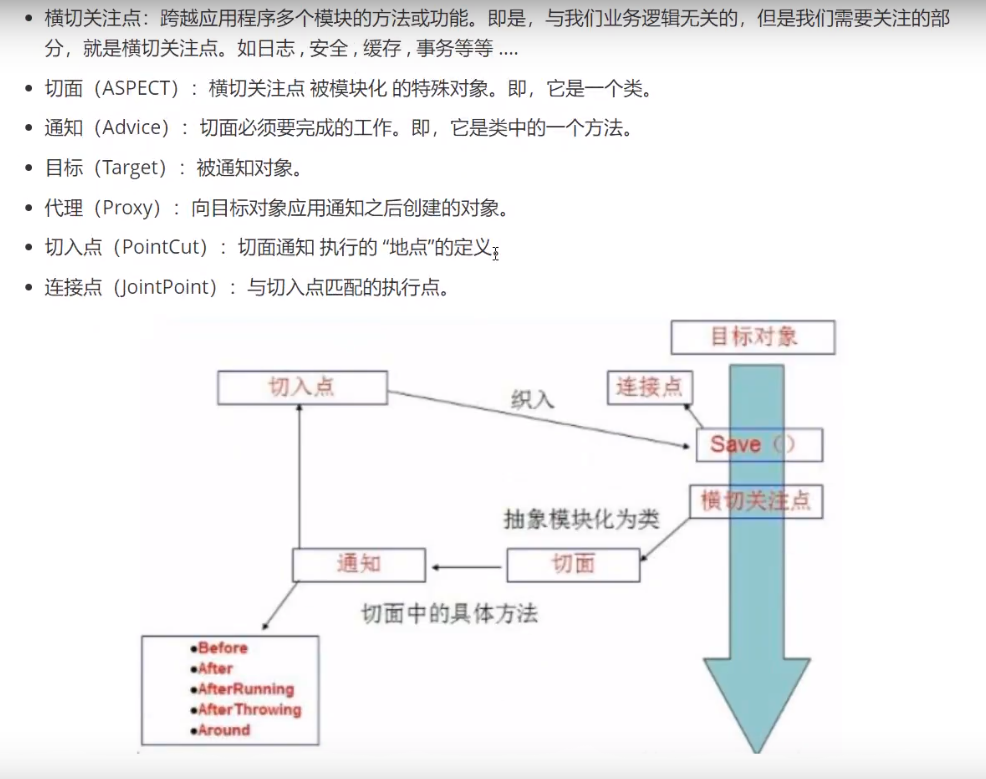
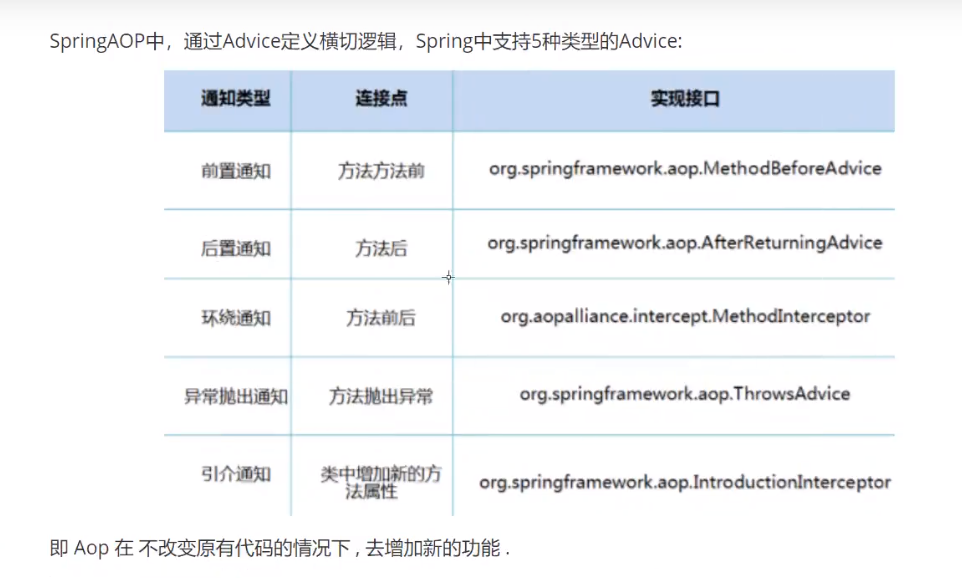
使用Spring实现AOP
首先导入织入的包
1 | <!-- https://mvnrepository.com/artifact/org.aspectj/aspectjweaver --> |
方式一: 使用Spring的API接口
public class Log implements MethodBeforeAdvice { /** * * @param method 要执行的目标对象的方法 * @param objects 参数 * @param o 目标对象 * @throws Throwable 异常 */ public void before(Method method, Object[] objects, Object o) throws Throwable { System.out.println(o.getClass().getName() + "的" + method.getName()+"被执行了"); } }
/**
* @author Lxb0124
* @create 2020-07-27 22:59
*/
public class AfterLog implements AfterReturningAdvice {
@Override
public void afterReturning(Object o, Method method, Object[] objects, Object o1) throws Throwable {
System.out.println(“执行了” + method.getName()+”, 返回结果为” +o);
}
}
1
2
3
4
5
6
7
8
9
10
11
12
13
14
15
16
17
18
19
20
21
22
23
24
25
26
27
2. ```xml
<?xml version="1.0" encoding="UTF-8"?>
<beans xmlns="http://www.springframework.org/schema/beans"
xmlns:xsi="http://www.w3.org/2001/XMLSchema-instance"
xmlns:context="http://www.springframework.org/schema/context"
xmlns:aop="http://www.springframework.org/schema/aop"
xsi:schemaLocation="http://www.springframework.org/schema/beans
http://www.springframework.org/schema/beans/spring-beans.xsd
http://www.springframework.org/schema/context
http://www.springframework.org/schema/context/spring-context.xsd
http://www.springframework.org/schema/aop
http://www.springframework.org/schema/aop/spring-aop.xsd">
<context:annotation-config/>
<bean id="userService" class="com.lxb.service.UserServiceImpl"/>
<bean id="log" class="com.lxb.log.Log"/>
<bean id="afterLog" class="com.lxb.log.AfterLog"/>
<aop:config>
<aop:pointcut id="pointcut" expression="execution(* com.lxb.service.UserServiceImpl.*(..))"/>
<aop:advisor advice-ref="log" pointcut-ref="pointcut"/>
<aop:advisor advice-ref="afterLog" pointcut-ref="pointcut"/>
</aop:config>
</beans>
public class Mytest { public static void main(String[] args) { ApplicationContext context = new ClassPathXmlApplicationContext("applicationContext.xml"); UserService userService = context.getBean("userService", UserService.class); userService.add(); } } <!--55-->在.xml 文件中配置
1
2
3
4
5
6
7
8
9<bean id="diy" class="com.lxb.DIY.DiyPointCut"/>
<aop:config>
<aop:aspect ref="diy">
<aop:pointcut id="point" expression="execution(* com.lxb.service.UserServiceImpl.*(..))"/>
<aop:before method="before" pointcut-ref="point"/>
<aop:after method="after" pointcut-ref="point"/>
</aop:aspect>
</aop:config>测试类不变, 结果为

方式三: 使用注解实现
创建类
1
2
3
4
5
6
7
8
9
10
11
12
13
14
15
16
17
18
19
20
21
22
23
24
25
26
27
28
29/**
* 使用注解方式实现AOP
*
* @author Lxb0124
* @create 2020-07-29 9:29
*/
public class AnnotationPointCut {
("execution(* com.lxb.service.UserServiceImpl.*(..))")
public void before() {
System.out.println("方法执行前");
}
("execution(* com.lxb.service.UserServiceImpl.*(..))")
public void after() {
System.out.println("方法执行后");
}
("execution(* com.lxb.service.UserServiceImpl.*(..))")
public void around(ProceedingJoinPoint joinPoint) throws Throwable {
System.out.println("环绕前");
joinPoint.proceed();
System.out.println("环绕后");
}
}在.xml中配置
1
2<bean id="annotationPointCut" class="com.lxb.DIY.AnnotationPointCut"/>
<aop:aspectj-autoproxy/>测试结果为

整合Mybatis
导入相关的jar包
首先是Spring相关的包, 略
Mybatis相关的包:
- mybatis
- mybatis数据库
还有一个新包:
mybatis-spring
1
2
3
4
5
6<!-- https://mvnrepository.com/artifact/org.mybatis/mybatis-spring -->
<dependency>
<groupId>org.mybatis</groupId>
<artifactId>mybatis-spring</artifactId>
<version>2.0.5</version>
</dependency>
目前所用到的所有Jar包依赖为:
1 | <!-- https://mvnrepository.com/artifact/org.springframework/spring-webmvc --> |
1 | <!--mysql驱动--> |
回顾Mybatis使用步骤
编写实体类
1
2
3
4
5
6
public class User {
private int id;
private String name;
private String pwd;
}编写核心配置文件
1
2
3
4
5
6
7
8
9
10
11
12
13
14
15
16
17
18
19
20
21
22
23
24
25
26
27
28
29
30
31
32
<configuration>
<settings>
<setting name="logImpl" value="STDOUT_LOGGING"/>
<setting name="mapUnderscoreToCamelCase" value="true"/>
<setting name="cacheEnabled" value="true"/>
</settings>
<typeAliases>
<package name="com.lxb.pojo"/>
</typeAliases>
<environments default="development">
<environment id="development">
<transactionManager type="JDBC"/>
<dataSource type="POOLED">
<property name="driver" value="com.mysql.jdbc.Driver"/>
<property name="url" value="jdbc:mysql://localhost:3306/mybatis?useSSL=false&useUnicode=true&characterEncoding=UTF-8"/>
<property name="username" value="root"/>
<property name="password" value="123456"/>
</dataSource>
</environment>
</environments>
<mappers>
<mapper class="com.lxb.mapper.UserMapper"/>
</mappers>
</configuration>编写接口
1
2
3public interface UserMapper {
public List<User> allUsers();
}编写Mapper.xml
1
2
3
4
5
6
7
8
9
10
11
12
13
14<?xml version="1.0" encoding="UTF-8" ?>
<!DOCTYPE mapper
PUBLIC "-//mybatis.org//DTD Mapper 3.0//EN"
"http://mybatis.org/dtd/mybatis-3-mapper.dtd">
<mapper namespace="com.lxb.mapper.UserMapper">
<select id="allUsers" resultType="user">
select * from mybatis.user;
</select>
</mapper>测试
1
2
3
4
5
6
7
8
9
10
11
12
13
14
public void test() throws IOException {
String resources = "mybatis-config.xml";
InputStream is = Resources.getResourceAsStream(resources);
SqlSessionFactory sqlSessionFactory = new SqlSessionFactoryBuilder().build(is);
SqlSession sqlSession = sqlSessionFactory.openSession(true);
UserMapper mapper = sqlSession.getMapper(UserMapper.class);
List<User> userList = mapper.allUsers();
for (User user : userList) {
System.out.println(user);
}
}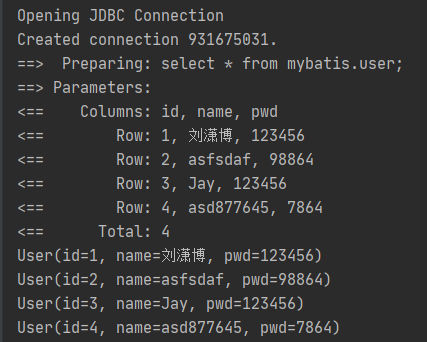
Mybatis-Spring
编写数据源
1
2
3
4
5
6
7<!-- DataSource-->
<bean id="datasource" class="org.springframework.jdbc.datasource.DriverManagerDataSource">
<property name="driverClassName" value="com.mysql.jdbc.Driver"/>
<property name="url" value="jdbc:mysql://localhost:3306/mybatis?useSSL=false&useUnicode=true&characterEncoding=UTF-8"/>
<property name="username" value="root"/>
<property name="password" value="123456"/>
</bean>可以选择其他的数据源格式
sqlSessionFactory
1
2
3
4
5
6<!-- sqlSessionFactory-->
<bean id="sqlSessionFactory" class="org.mybatis.spring.SqlSessionFactoryBean">
<property name="dataSource" ref="datasource"/>
<property name="configLocation" value="classpath:mybatis-config.xml"/>
<property name="mapperLocations" value="classpath*:com/lxb/mapper/*.xml"/>
</bean>这里可以配置Mybatis的各种参数, 相当于配置Mybatis中的环境部分, 别名和设置也可以在这里配置, 但是习惯上不写在这里.
sqlSessionTemplate
1
2
3<bean id="sqlSession" class="org.mybatis.spring.SqlSessionTemplate">
<constructor-arg index="0" ref="sqlSessionFactory"/>
</bean>只能构造器注入, 因为没有set方法
给接口加实现类
1
2
3
4
5
6
7
8
9
10
11
12
13
14public class UserMapperImpl implements UserMapper{
private SqlSessionTemplate sqlSession;
public void setSqlSession(SqlSessionTemplate sqlSession) {
this.sqlSession = sqlSession;
}
public List<User> allUsers() {
UserMapper mapper = sqlSession.getMapper(UserMapper.class);
return mapper.allUsers();
}
}1
2
3
4
5<import resource="spring-dao.xml"/>
<bean id="userMapper" class="com.lxb.mapper.UserMapperImpl">
<property name="sqlSession" ref="sqlSession"/>
</bean>1
2
3
4
5
6
7
8
9
10
11
12
<mapper namespace="com.lxb.mapper.UserMapper">
<select id="allUsers" resultType="user">
select * from mybatis.user;
</select>
</mapper>
测试
1
2
3
4
5
6
7
8
9
10
public void test() throws IOException {
ApplicationContext context = new ClassPathXmlApplicationContext("ApplicationContext.xml");
UserMapper userMapper = context.getBean("userMapper", UserMapperImpl.class);
List<User> userList = userMapper.allUsers();
for (User user : userList) {
System.out.println(user);
}
}
方式二: 进一步简化
以上所述的方法中, 在获得sqlSessionFactory之后, 还要将它注入到SqlSessionTemplate获得sqlSession, 然后需要手动编写UserMapperImpl类, 并在容器中注册, 使用官方提供的SqlSessionDaoSupport类, 就可以跳过SqlSessionTemplate步骤, 直接把sqlSessionFactory注入即可
1 | public class UserMapperImpl2 extends SqlSessionDaoSupport implements UserMapper { |
1 | <bean id="userMapper2" class="com.lxb.mapper.UserMapperImpl2"> |
测试:
1 |
|
声明式事物
回顾事物
- 把一组业务当做一个业务来做, 要么都成功, 要么都失败
- 涉及到数据的一致性问题, 不能马虎
- 确保完整性和一致性
ACID:
- 原子性
- 一致性
- 隔离性
- 多个业务可能操作同一个资源, 防止数据损坏
- 持久性
- 事物一旦提交, 无论系统发生什么问题, 结果都不会被影响, 被持久化地写到存储器中
Spring声明式事物
一个使用 MyBatis-Spring 的其中一个主要原因是它允许 MyBatis 参与到 Spring 的事务管理中。而不是给 MyBatis 创建一个新的专用事务管理器,MyBatis-Spring 借助了 Spring 中的 DataSourceTransactionManager 来实现事务管理。
要开启 Spring 的事务处理功能,在 Spring 的配置文件中创建一个 DataSourceTransactionManager 对象:
1 | <bean id="transactionManager" class="org.springframework.jdbc.datasource.DataSourceTransactionManager"> |
Spring中的事物管理
- 声明式事物: AOP
- 编程式事物: 需要在代码中, 进行事物的管理(忽略)
需要导入的约束:
1 | xmlns:tx="http://www.springframework.org/schema/tx" |
开启事物的语句:
1 | <bean id="transactionManager" class="org.springframework.jdbc.datasource.DataSourceTransactionManager"> |
编写事物并织入方法:
1 | <tx:advice id="txAdvice" transaction-manager="transactionManager"> |

